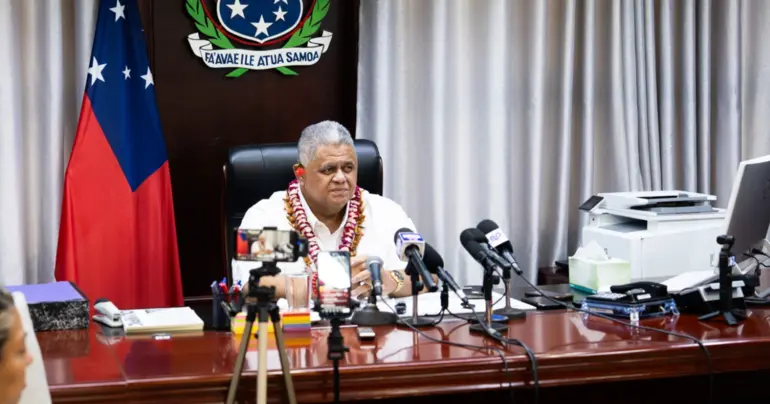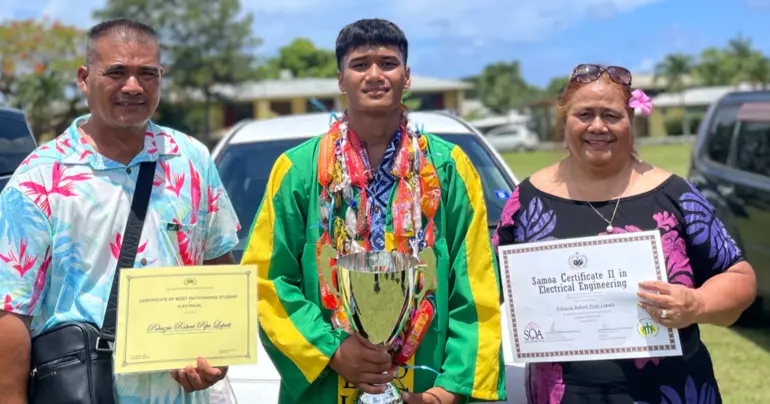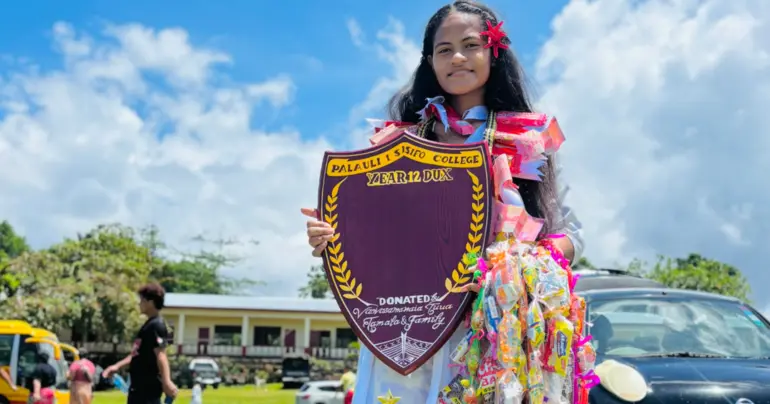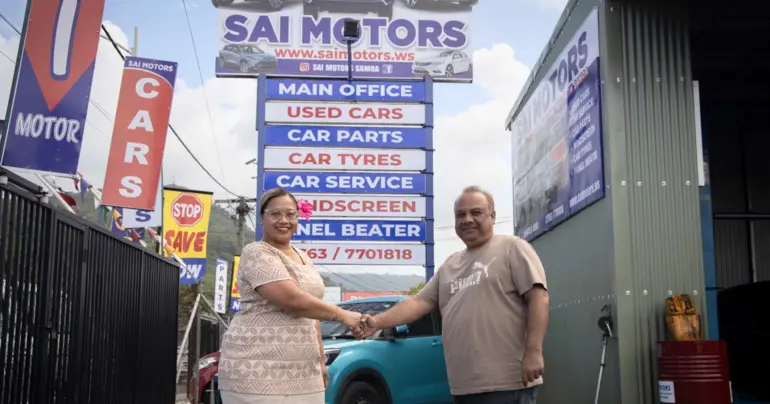Rare plant garden a legacy of U.S. ethnobotanist
 By Marc Membrere
•
14 June 2021, 2:00PM
By Marc Membrere
•
14 June 2021, 2:00PM
The partner of the American ethnobotanist, academic and writer the late Dr. Art Whistler is grateful that a garden named in his honor will further his legacy while also protecting Samoa's biodiversity.
The Art Whistler Memorial Garden is being constructed in a partnership between the Samoa Conservation Society (S.C.S) and the Ministry of Natural Resources and Environment.
The Art Whistler Memorial Garden will be located at the Vailima Botanical gardens. Native and endangered Samoan plant species have been introduced to the garden in a bid to save them from extinction.
The garden is 90 per cent complete and hopes to open its doors on 24 July. The garden will also serve as a kind of backup for rare and endangered Samoan plant species.
In a response to Samoa Observer email queries, Alice Campbell said she is grateful to be able to do something to further Art’s legacy in Samoa and the South Pacific.
“This rare plant garden is the perfect project, one that I learnt that he had asked for several times and here it has become a reality, thanks to the collaborative efforts of so many in Samoa,” she said.
“What pleases me the most is that this garden has barrier free access, allowing everyone to come, learn about the rare plants and enjoy a peaceful time in the garden.
Ms. Campbell is appreciative of the local support, including Rotary Samoa, and international support from family, friends and colleagues of Dr. Whistler through the Givealittle to further the progress of the garden.
"They have all contributed to making this dream a reality," she said.
She last visited Samoa in October 2019 together with her late partner when he was doing a BioRap in Savai'i and she enjoyed the experience.
“It was an amazing experience as we spent two nights on Upolu then the rest of the time on Savai'i near Asau. Art so wanted to bring me to his world, and it was incredible adventure."
She explained that she was amazed by the verdant, natural beauty of Samoa and was also amazed by the warm and welcoming people.
“Immediately I could understand his connection to this country,” she said.
She said that she was able to go part way up Mt. Silisili and see Dr. Whistler at work.
“He never missed an opportunity to walk in the forest, always hoping to find a rare plant. He was so dedicated and I was thrilled to be in his world. My surprise was the Flying Foxes,” she said
“At first I thought they were eagles or osprey as they were so large, yet they didn’t look quite like birds.
She was amazed to find out they were bats due to the size and added that Dr. Whistler explained their importance in Samoa’s biodiversity and she was even more impressed.
Ms. Campbell said that everyone knew “Tupu o le Vao” and were pleased to have him stay with them as he had so many times before.
She added that all of the staff made an effort to talk to him and welcome him back and Dr. Whistler surprised many with his mastery of the Samoan language.
She said she wants to return to Samoa and had hopes to be back in the country for the opening of the garden.
“Art’s daughter, Kira Matangi and I had planned to come to Samoa for that. While we will miss it, I know that we will come when travel is once again safe and we can walk in the garden ourselves,” she said.
According to Ms. Campbell, the original idea of the garden was planted by Samoa Conservation Society (S.C.S) President James Atherton right after Dr. Whistler passed away.
She said that in April of 2020 Mr. Atherton wrote "What about we develop a small memorial garden at the Vailima botanical gardens in Art’s memory? We could plant some of the rare plants we have been collecting.”
She added that in late April, this idea was fast tracked and they started gathering ideas and making plans.
“It was the focus I needed to go forward after losing Art, and during the difficult time of Covid isolation. The Samoa Conservation Society and James Atherton were instrumental in providing guidance, support and plain old hard work to bring the plans from an idea into reality,” she said.
Ms. Campbell said the S.C.S. Executive Member Steve Brown has continually “kept his finger on the pulse” of the garden, and has tirelessly kept it beating in memory of his friend.
“In doing research for the garden, I found that Art had asked for such a garden as recently as December of 2017 in his online lecture, the Flora of Samoa.
"Prior to that he had mentioned it in a botanical paper in 2010. Furthermore he had lamented to me that, with each IUCN Red List, more and more plants were either disappearing or added to the endangered list. This was the right project to further the legacy of the King of the Forest.
“We were all grateful to M.N.R.E. for allowing us to recognise the tremendous legacy left by Dr. Art Whistler by giving us space at the Vailima Botanical Garden to dedicate to the preservation and protection of Samoa’s rare and endangered plants.
“My first donation to the garden was to fund the building of a traditional fale. Art loved his traditional fale, which he had built over a decade ago, in his garden in Honolulu.
"I wanted such a fale in the memorial garden to showcase Samoan skills and traditional knowledge, thereby reflecting Art’s study of ethnobotany - the use of native plants in Samoan life and culture. When I mentioned this to Art’s daughter, Kira, she then also contributed to the fale."
She said that originally they were going to build a fale as the first location for the Art Whistler Memorial Garden at the other end of Vailima Botancal Garden and that Tuatagaloa Joe Annandale was to supervise its construction.
Ms. Campbell added that as plans were drawn up last June, Tuatagaloa expressed concern that the fale would be “taken out” by a fallen tree which Ms. Campbell explained was a likelihood in that forested area.
She said once M.N.R.E. approved moving the garden to its current location, it had the advantage of an existing fale and under Tuatagaloa’s guidance, his team diligently restored the existing fale using traditional methods and to a traditional standard.
Ms. Campbell said she is proud to be an active member of the S.C.S. and keeps up to date on their projects, and is looking forward to volunteering with them in the forests, the bird hide and the garden when she returns to Samoa.
“I am interested in bird life, and in particular in the Manumea, and furthering the efforts to find and protect what might be the last, if any, remaining birds," she said.
"In addition, I am supporting preservation and restoration of the mangroves at Moataa, and doing all that I can to further ecotourism in Samoa. Much time has been spent proofreading grant applications, something that can be easily done long distance."
She said climate change is a real problem and is an emergency for Samoa and all South Pacific Island nations.
"I am in support of the declaration of such an emergency across the South Pacific in the hopes that one unified voice from the island nations will have a greater impact upon the larger nations of the world," she said.
She said that Tuatagaloa had suggested a raised walkway at the old garden site, where he acknowledged that the natural path was difficult to navigate for those with mobility issues.
“It had never occurred to me that accessibility could be an issue, and that access to the garden would not be universal. In my city, all parks have paved pathways, so this was unfamiliar to me."
She said that to learn more about barrier free access she Googled and learned about Nuanua o le Alofa (N.O.L.A).
“I learned that there are few opportunities available to them to enjoy nature, much less deal with daily obstacles,” she said.
She said that N.O.L.A was instrumental in bringing assessors to the garden to provide guidance on correct barrier free access and that they have been supportive of this project.
“My next contribution was to facilitate the poured pathways in the garden,” she said.
Ms. Campbell was delighted to learn that part of the mix was crushed recycled glass, which she said was a first for Samoa.
“Now we are hoping that further donations will allow us to extend the pathway to both the carpark and to the waterfall viewing area,” she said.
“It is my hope that many in Samoa will come and visit the garden, learn about their native plants and their uses in Samoan life, appreciate the legacy of Dr. Art Whistler and spend some relaxing time in nature.”
 By Marc Membrere
•
14 June 2021, 2:00PM
By Marc Membrere
•
14 June 2021, 2:00PM











